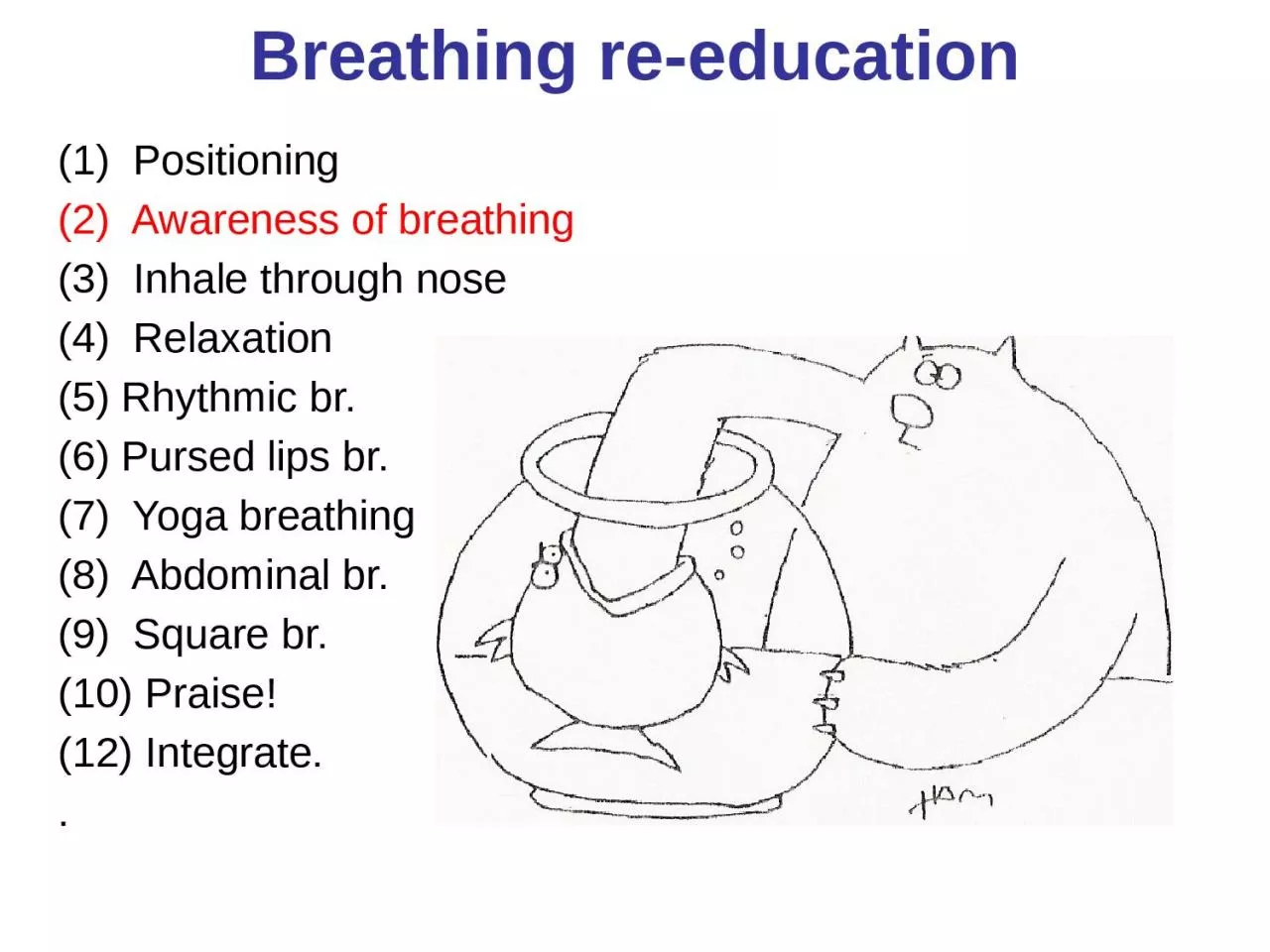

2 Awareness of breathing 3 Inhale through nose 4 Relaxation Rhythmic br Pursed lips br 7 Yoga breathing 8 Abdominal br 9 Square br Praise 12 Integrate ID: 920917
Download Presentation The PPT/PDF document "Breathing re-education (1) Positioning" is the property of its rightful owner. Permission is granted to download and print the materials on this web site for personal, non-commercial use only, and to display it on your personal computer provided you do not modify the materials and that you retain all copyright notices contained in the materials. By downloading content from our website, you accept the terms of this agreement.
Slide1
Breathing re-education
(1) Positioning(2) Awareness of breathing (3) Inhale through nose (4) RelaxationRhythmic br.Pursed lips br.(7) Yoga breathing(8) Abdominal br.(9) Square br. Praise!(12) Integrate..
Slide2Breathing re-education
(1) Positioning(2) Awareness of breathing (3) Inhale through nose (4) RelaxationRhythmic br.Pursed lips br.(7) Yoga breathing(8) Abdominal br.(9) Square br. Praise!(12) Integrate..
Slide3Breathing re-education
(1) Positioning(2) Awareness of breathing (3) Inhale through nose if poss(4) Relaxation(5) Rhythmic breathing(6) Pursed lips breathing(7) Yoga breathing(8) Abdominal breathing(9) Square breathing Praise!(12) Integrate.
.
Slide4Relaxation may slow breathing
RR increases turbulence
Slide5Relaxation – getting out of the vicious cycle
Slide6(4) Relaxation
– follow up‘…5-year follow-up showed that hospitalisation for cardiac problems was still lower in the relaxation group’.Gilbert 1999
Slide7(4) Relaxation
‘Symptom relief and time constraints seem to be the primary factors affecting compliance’ Lazo 2003
Slide8Breathing re-education
(1) Positioning(2) Awareness of breathing (3) Inhale through nose if poss(4) Relaxation(5) Rhythmic breathing(6) Pursed lips breathing(7) Yoga breathing(8) Abdominal breathing (diaphragmatic/breathing control)(9) ? practise different breathing patterns (not with severe SOB) Square breathing Praise!
(12) Integrate.
.
Slide9Slide10Breathing re-education
(1) Positioning(2) Awareness of breathing (3) Inhale through nose(4) Relaxation(5) Rhythmic breathing(6) Pursed lips breathing(7) Yoga breathing(8) Abdominal breathing (9) Square breathing Praise!(12) Integrate..
Slide11Breathing re-education
(1) Positioning(2) Awareness of breathing (3) Inhale through nose if poss(4) Relaxation(5) Rhythmic breathing(6) Pursed lips breathing(7) Yoga breathing(8) Abdominal breathing (diaphragmatic/breathing control)(9) Square breathing Praise!(12) Integrate..
Slide12‘Grounding the energy’
Slide13Breathing re-education
(1) Positioning(2) Awareness of breathing (3) Inhale through nose if poss(4) Relaxation(5) Rhythmic breathing(6) Pursed lips breathing(7) Yoga breathing(8) Abdominal breathing (diaphragmatic/breathing control)(9) ? practise different breathing patterns (not with severe SOB) Square breathing Praise!
(12) Integrate.
.
Slide14Breathe in:feel the air filling up your stomach like a balloon
Breathe out:allow your stomach to sink inwards
Slide15
diaphragmatic breathing SOB and hypoxaemia in most COPD patients
in some with severe COPD it may cause asynchronous breathing and
SOB
Fernandes
M,
Cukier
A,
Feltrim
MIZ (2011) Efficacy of diaphragmatic breathing in patients with chronic obstructive pulmonary disease.
Chron
Respir
Dis
, 8, 237-44
breathing and SOB
Slide16Critique
‘A pattern of slow exhalation with pursed lips is stressed. This is commonly referred to as abdominal breathing, diaphragmatic breathing or breathing exercises.’Berzius (1970) An occupational therapy programme for the COPD patient. Am J OT, 24, 181-6
Slide17Critique
‘A pattern of slow exhalation with pursed lips is stressed. This is commonly referred to as abdominal breathing, diaphragmatic breathing or breathing exercises.’Berzius (1970) An occupational therapy programme for the COPD patient. Am J OT, 24, 181-6
Slide18Breathing re-education
(1) Positioning(2) Awareness of breathing (3) Inhale through nose if poss(4) Relaxation(5) Rhythmic breathing(6) Pursed lips breathing(7) Yoga breathing(8) Abdominal breathing (diaphragmatic/breathing control)? practise different breathing patterns (not with severe SOB)
-
enables patients to feel in control
(10) Breathing round a square
(11) Praise!
(12) Integrate.
Slide19.
. Breathing re-education (1) Positioning
(2) Awareness of breathing
Inhale through nose
Relaxation
(5) Rhythmic breathing
(6) Pursed lips breathing
(7) Yoga breathing
Abdominal breathing
? practise different breathing patterns
(10) Square breathing
(11) Praise!
(12) Integrate
‘
Breathe in along one side, breathe out along the next side, pause at each corner.’
Slide20Look around for a rectangle e.g. a window or picture. Follow the sides with your eyes as you breathe.Try slowing the speed that your eyes move round, pausing at the corners.
Slide21(11) Praise!
Slide22(12) Integrate
n
Slide23Integrate with activities?(difficult)
Integrate when getting breath back?(easier)
Slide24Lean on something to get your breath back
Slide25Lean on your shopping trolley - positioning + ADL
Slide26Pacing
Slide27Pacing and stairs get it over and done with, then heave over the banister to get breath back
– No co-ordinate breathing with steady stepping up – Yes
Slide28Pacing and stairs:
In/out in/out in/out :
- bring both feet onto each step
In-out–out : in–out–out :
- one foot on each step
Slide29End of stairs
“Wonderful! Just wonderful!…
So much for instilling them with a sense of awe.”
Slide30Good Practice Points‘If the patient walks slightly flexed, it is worth consideration of the above facts before correcting posture
‘For those patients who do not need or wish to use a walking aid, methods for passively fixing the shoulder girdle when ambulating should be taughthands in pockets or thumbs in belt loops/waistbandshands resting on a handbag, carried by an across the shoulder strap.’ ACPRC + BTS
Slide31End of
breathless management
Slide32